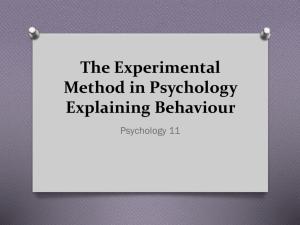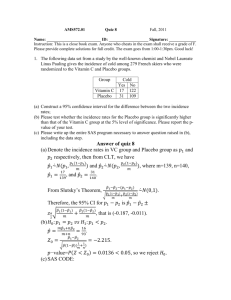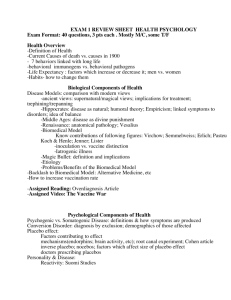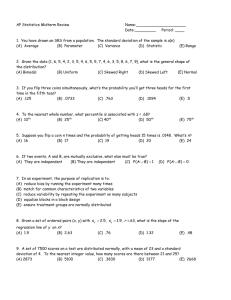Policy Number: 43 Title: Use of a Placebo
advertisement
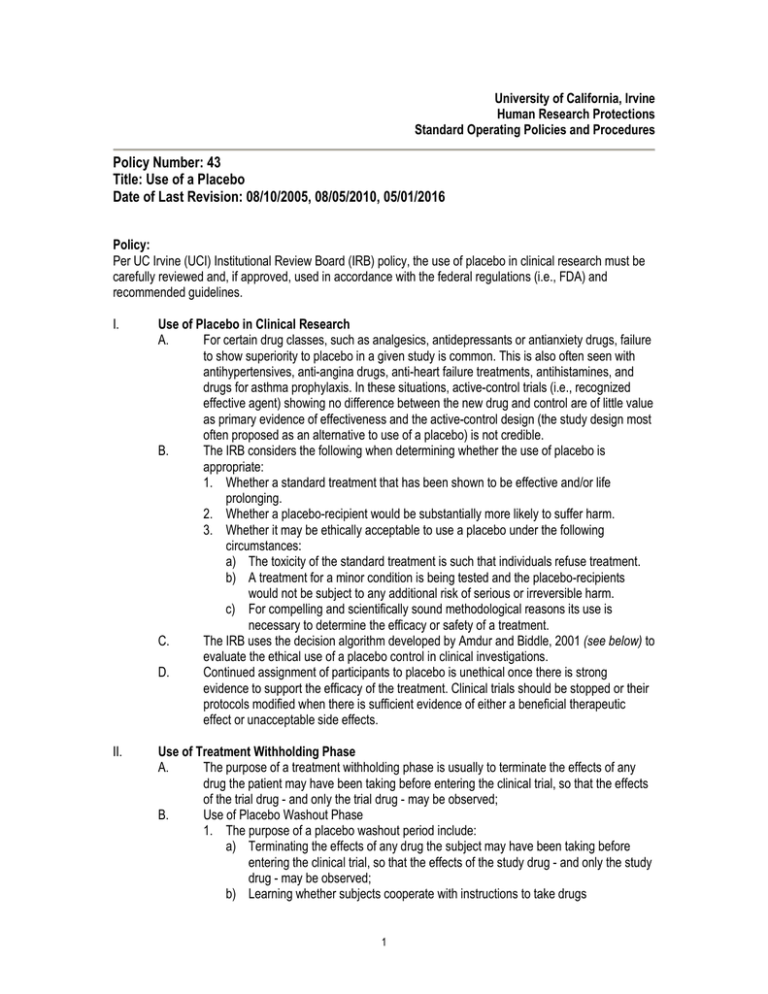
University of California, Irvine Human Research Protections Standard Operating Policies and Procedures Policy Number: 43 Title: Use of a Placebo Date of Last Revision: 08/10/2005, 08/05/2010, 05/01/2016 Policy: Per UC Irvine (UCI) Institutional Review Board (IRB) policy, the use of placebo in clinical research must be carefully reviewed and, if approved, used in accordance with the federal regulations (i.e., FDA) and recommended guidelines. I. Use of Placebo in Clinical Research A. For certain drug classes, such as analgesics, antidepressants or antianxiety drugs, failure to show superiority to placebo in a given study is common. This is also often seen with antihypertensives, anti-angina drugs, anti-heart failure treatments, antihistamines, and drugs for asthma prophylaxis. In these situations, active-control trials (i.e., recognized effective agent) showing no difference between the new drug and control are of little value as primary evidence of effectiveness and the active-control design (the study design most often proposed as an alternative to use of a placebo) is not credible. B. The IRB considers the following when determining whether the use of placebo is appropriate: 1. Whether a standard treatment that has been shown to be effective and/or life prolonging. 2. Whether a placebo-recipient would be substantially more likely to suffer harm. 3. Whether it may be ethically acceptable to use a placebo under the following circumstances: a) The toxicity of the standard treatment is such that individuals refuse treatment. b) A treatment for a minor condition is being tested and the placebo-recipients would not be subject to any additional risk of serious or irreversible harm. c) For compelling and scientifically sound methodological reasons its use is necessary to determine the efficacy or safety of a treatment. C. The IRB uses the decision algorithm developed by Amdur and Biddle, 2001 (see below) to evaluate the ethical use of a placebo control in clinical investigations. D. Continued assignment of participants to placebo is unethical once there is strong evidence to support the efficacy of the treatment. Clinical trials should be stopped or their protocols modified when there is sufficient evidence of either a beneficial therapeutic effect or unacceptable side effects. II. Use of Treatment Withholding Phase A. The purpose of a treatment withholding phase is usually to terminate the effects of any drug the patient may have been taking before entering the clinical trial, so that the effects of the trial drug - and only the trial drug - may be observed; B. Use of Placebo Washout Phase 1. The purpose of a placebo washout period include: a) Terminating the effects of any drug the subject may have been taking before entering the clinical trial, so that the effects of the study drug - and only the study drug - may be observed; b) Learning whether subjects cooperate with instructions to take drugs 1 C. ("compliance"); and c) Learning which subjects are "placebo responders," in that they experience a high degree of placebo effect. In some studies, the researcher may plan to exclude those subjects they find either poorly compliant or highly responsive to the placebo. III. Use of Placebo and Informed Consent A. The informed consent document must include the following information: 1. Statement that the study involves a placebo; 2. Lay definition of placebo or placebo-washout, if applicable; 3. Rationale for use of placebo; 4. A description of how participants will be assigned to groups; 5. List of any viable treatment alternatives, if applicable; 6. Explanation of the duration of time that a participant will receive placebo; 7. A statement regarding the degree of discomfort and potential effects of not receiving treatment; 8. Explanation of consequences of delayed treatment must be included, if applicable; 9. Explanation that a placebo-recipient’s condition may worsen while on placebo; 10. A statement that a placebo-recipient’s will not receive the same benefit as those who receive active treatment if that treatment is effective; 11. A explanation of blinding (e.g., single-blind; double-blind), if applicable; and 12. A brief description of the safety monitoring process. IV. Methods to Minimize Risks Associated with Use of Placebo A. Exclude subjects with an increased risk of harm from non-response. B. Include increased monitoring for subject deterioration and the use of rescue medications. C. Build in "early escape" mechanisms and explicit withdrawal criteria so subjects will not undergo prolonged placebo treatment if they are not doing well. D. Keep the size of the population placed on placebo smaller than the number in active treatment arms. E. Compare placebo and active treatment in an "add-on" method, keeping the subjects on identical maintenance treatments and then adding on the active treatment to one arm and placebo to the other. This design is especially applicable when the available treatment is known to decrease mortality or morbidity. F. Shorten treatment periods to reduce the risks associated with delayed treatment. 1. In situations in which long-term placebo treatment would not be acceptable, the use of a placebo group for a short period at the beginning of a trial could establish shortterm effects. The trial would then continue without the placebo group. G. Unblinded data review by a Data Safety Monitoring Board (DSMB) with interim analysis of study results and safety issues. References: 21 CFR 56.111 21 CFR 314.126 45 CFR 46.11 2 Procedure Number: 43.A Title: Procedure for the Use of a Placebo Procedure: The purpose of this procedure is to provide guidance on the use of a placebo in research. I. Lead Researcher (LR) Responsibilities A. The Lead Researcher will provide all information regarding the use of a placebo as required in the IRB Application (Appendix L) and protocol narrative. This will include: 1. A description of how participants will be assigned to groups; 2. Explanation of the duration of time that a participant will receive placebo. 3. Whether a proven standard treatment/therapy exists to treat the disease/condition being studied. 4. Whether the standard treatment/therapy is considered to be effective. 5. Justification for the use of the placebo. 6. Whether standard therapy is given to mitigate permanent harms (e.g., psychological harm, disfigurement or other serious adverse sequelae) or whether it is given to treat symptoms that constitute inconvenience or discomfort only. 7. Whether the disease/condition being treated has the potential to progress to a higher risk condition if not actively treated. 8. Whether the natural fluctuation of the disease/condition is significant enough to necessitate the use of placebo to determine if the observed changes are due to treatment or natural history. 9. Whether subjects in the placebo group would be exposed to an increased risk of death, severe morbidity or disability, severe discomfort, or other long-term negative effects. 10. Description of the safety monitoring process, including withdrawal criteria. B. The Lead Researcher will include the following information in the informed consent document: 1. Statement that the study involves a placebo; 2. Lay definition of placebo or placebo-washout, if applicable; 3. Rationale for use of placebo; 4. A description of how participants will be assigned to groups; 5. List of any viable treatment alternatives, if applicable; 6. Explanation of the duration of time that a participant will receive placebo; 7. A statement regarding the degree of discomfort and potential effects of not receiving treatment; 8. Explanation of consequences of delayed treatment must be included, if applicable; 9. Explanation that a placebo-recipient’s condition may worsen while on placebo; 10. A statement that a placebo-recipient will not receive the same benefit as those who receive active treatment if that treatment is effective; 11. A explanation of blinding (e.g., single-blind; double-blind), if applicable; and 12. A brief description of the safety monitoring process. C. The Lead Researcher will notify the IRB of any amendments, unanticipated problems to participants or others that may occur while conducting the research or follow-up. D. The Lead Researcher will assure that unanticipated problems to participants or others are reported to the IRB via the UCI Unanticipated Problems (UP) application process as soon as possible, but no later than 5 working days after the LR first learns of the effect or problem (See HRP Policy # 19) 3 II. IRB Committee Responsibilities A. The Committee will review the proposed research, informed consent documents, and additional information, when appropriate, and determine whether the study meets criteria 45 CFR 46.111 and 21 CFR 56.111 for approval. 1. In order to provide written documentation, the primary and secondary reviewers must complete the “IRB Reviewer’s Checklist” form specifying how the criteria are met. 2. In making its determination on approval, the IRB must consider whether the protocol is scientifically sound. The IRB should consider the risks and benefits of the use of a placebo compared to the risks and benefits of alternative options. The research is to be reviewed with all risks and benefits taken into consideration, not just the use of a placebo. This should include: a) Consideration of prior reviews by the FDA, other institutions, scientific review committees, funding agencies (e.g., NIH), or others; and b) Study design, which includes the study population, the trial phase, and mechanisms for data analysis and surveillance. B. Submission of modifications, unanticipated problems to participants or others, and continuing reviews will be reviewed at the level for which they qualify. III. IRB Administrator Responsibilities A. The Administrator will pre-review and request any necessary revisions for Appendix L for use of placebo as outlined for new application. B. The Administrator will assist reviewers in obtaining additional information that may be requested regarding the use of placebo from the LR. C. The Administrator will document the Committee’s rationale for use of placebo in the minutes. D. Letters requesting revisions from reviewers are sent to the LR. E. Final approval letters are to be drafted using the appropriate template and provided to the Chairperson or his/her designee for signature. F. The HRP staff will process all requests for amendments, unanticipated problems to participants or others, and continuing reviews per corresponding policies and procedures. References: 21 CFR 56.111 21 CFR 314.126 45 CFR 46.111 Amdur, R.J. and Biddle C., An Algorithm for Evaluating the Ethics of Placebo-Controlled Clinical Trials, Radiation Oncology Investigations, (2001), John Wiley and Sons, Inc. FDA Guidance 1998 Update for Institutional Review Boards and Clinical Investigators Drugs and Biologics Drug Study Designs 4 5

